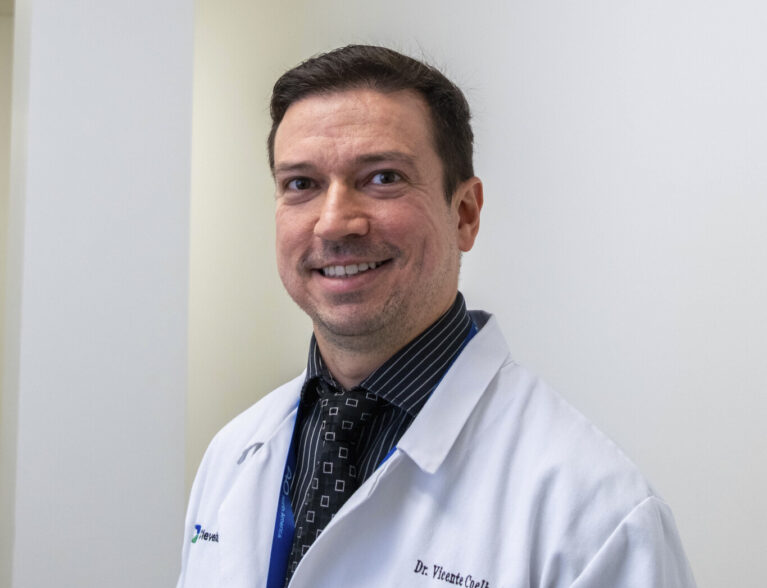
“Oh, my aching back!” is a common lament for millions of Americans. In fact, back pain is one of the main reasons people visit the doctor, and when treatments like massage, physical therapy, medications or injections fail, surgery becomes an option in the quest for relief.
The idea of back surgery can be frightening, but thanks to ongoing advances in medical technology, many patients now can be treated in a minimally invasive manner with endoscopic spine surgery.
“This is an emerging technique for treating spinal pathology,” said Dr. Vicente Coelho, a neurosurgeon at Cleveland Clinic Indian River Hospital. “It’s an ultra-minimalist procedure using small incisions which are often less than one half inch.
“We have the gold standard of open surgery procedures. Then we shifted to minimal manual techniques. And now we have endoscopic spine surgery using the endoscope, a very specialized instrument with a high-definition camera. It’s different from the traditional open spine surgery which often has significant muscle dissection and bone removal. The endoscopic spine approach is designed to minimize tissue disruption so we can reduce blood loss. It translates into a faster recovery.”
This less traumatic procedure, which uses a tiny camera (endoscope) and specialized surgical tools to treat spinal conditions, guides surgeons by real time video imaging as they remove herniated discs, relieve pressure on nerves and treat spinal stenosis. Unlike traditional open back, which involves large incisions and muscle dissection, endoscopic tools slip between muscles rather than cutting through them.
“Not all patients are good candidates for this kind of procedure,” Dr. Coelho said. “We need to take a look at the images and do a precise examination. Patients with severe spinal instability and certain complex conditions may still require open surgery or other types of minimally invasive procedures.”
Endoscopic spinal surgery can be used for a variety of conditions but it’s most useful for patients with disc protrusions, where the standard approach would involve removal of supportive bony structures. The minimally invasive approach with endoscopy results in fewer permanent biomechanical alterations following surgery.
“We use geomapification – like a GPS system based on the data,” Dr. Coelho explained. “We can obtain the images using the MRI and then export those images to a platform that makes trajectories of the entry point and target area. It’s very precise.”
Typically, the procedure is done with the patient under local anesthesia with sedation or general anesthesia. A small incision is made near the spine, and the surgeon inserts a thin tube called a cannula to create a pathway to the surgical site.
An endoscope with a camera is threaded through the cannula, providing a magnified view of the spine on a monitor. The surgeon uses miniature instruments to remove or repair damaged tissue or bone. Afterward, the incision is closed with a small stitch or adhesive. The entire process typically takes less than an hour for many common conditions.
Studies suggest that endoscopic spine surgery can be just as effective as open surgery for certain conditions, with fewer complications and quicker recovery. Recent research published in The Spine Journal found that endoscopic discectomy for herniated discs has comparable long-term outcomes to traditional micro discectomy, with the added benefits of less pain, shorter hospital stays and quicker returns to everyday activities.
“Right now, I estimate that only about 10 percent of my spinal procedures are done endoscopically.” Dr. Coelho said. “Most of my cases are fusion procedures. But for those patients who cannot go through a more invasive procedure or undergo general anesthesia, this may be a safer, less invasive way to address their problem with fewer risks because we are not refurbishing the whole spine.
“We may not be able to make them pain free but at least we can eliminate about 80 percent of the pain using this very minimally invasive procedure and they can go home the same day. Patients can drive in about five days and experience a complete recovery between four to six weeks.
According to Mayo Clinic, disc herniation is most often the result of gradual, aging-related wear and tear called disk degeneration. As people age, the discs become less flexible and more prone to tearing or rupturing, sometimes with just a minor strain or twist. Most herniated discs occur in the lower back and often affect just one side of the body.
Symptoms depend on where the disc is sitting and whether it is pressing on a nerve. If the herniated disc is in your lower back, you’ll feel pain in your lower back, buttocks, thigh and calf.
If it’s in your neck, you most likely feel pain in your shoulder and arm. The pain is often described as sharp or burning.
People with herniated discs may also experience radiating numbness or tingling in the body part served by the affected nerves and a weakness in the adjoining muscles.
Stenosis is another condition that often can be treated with endoscopic spinal surgery. Spinal stenosis is a condition where the spaces within your spinal canal narrow, potentially compressing the spinal cord and nerve roots.
“The inflammation from chronic arthritis and growing of anomalous calcifications narrow the spinal canal and ends up compressing the nerves,” Dr. Coelho said. “In surgery, we need to remove bone and calcified ligaments to create more space. The endoscopic technique can be just as effective as using tubes or open tunnel procedures, depending on the patient and their specific condition.”
If you are suffering from chronic back pain and considering surgery, it makes sense to consult with a spine specialist who can evaluate your condition and help determine whether endoscopic surgery would be your best choice.
Vicente Coelho, MD, is a neurosurgeon at Cleveland Clinic Indian River Hospital who specializes in minimally invasive spine surgery. His office is located at 1155 35th Lane, Vero Beach. Call 772-563-4741 for an appointment.



